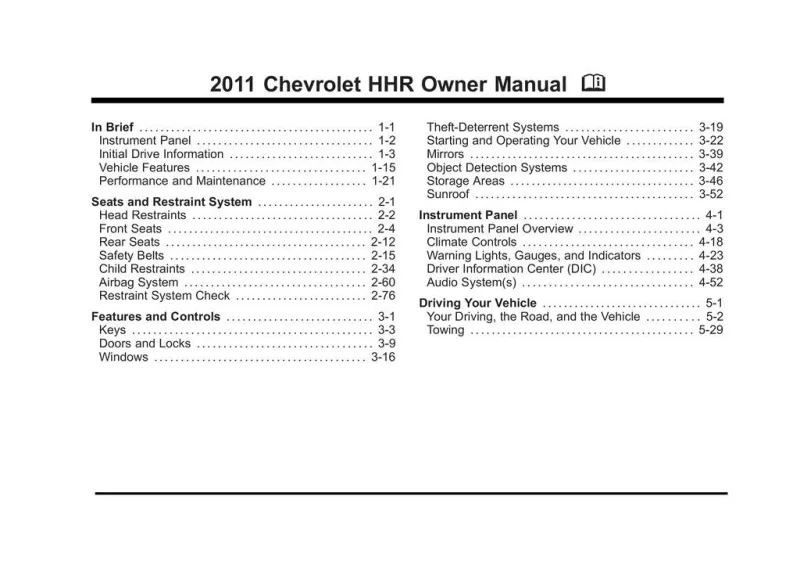2011 Chevrolet Hhr Owner's Manual

Table of Contents
2011 Chevrolet Hhr Overview
Introduction
The 2011 Chevrolet HHR (Heritage High Roof) is a versatile and stylish compact crossover that blends retro design elements with modern functionality. Inspired by the classic Chevrolet models of the past, the HHR has a unique boxy shape that sets it apart from traditional sedans and SUVs. This model caters to a range of drivers, from families needing extra cargo space to individuals seeking a stylish daily commuter, effectively making it a practical option without compromising on flair.
Powertrains
The 2011 HHR offers two capable powertrains to suit diverse driving preferences. The base model features a 2.2-liter four-cylinder engine, producing a respectable 149 horsepower and 155 lb-ft of torque. For those seeking a bit more thrill behind the wheel, an optional 2.4-liter four-cylinder engine is available, generating up to 172 horsepower and 167 lb-ft of torque. Both engines come with a choice of either a five-speed manual or a four-speed automatic transmission, providing smooth handling and efficient performance whether navigating city streets or cruising on the highway.
Trims
This model year of the HHR is available in three distinct trims: LS, 1LT, and 2LT. The LS trim serves as the introductory option, offering essential features and a solid foundation. The 1LT adds more amenities, including upgraded audio options and alloy wheels, while the 2LT trim tops the lineup with additional luxury and convenience features, such as premium seating materials, sunroof availability, and enhanced sound systems to elevate the driving experience.
Features
Chevy equipped the HHR with a range of standard and available features designed to enhance comfort and convenience. With spacious interior dimensions and a flat-load floor, the HHR is perfect for stowing gear or accommodating extra passengers. Notable amenities include Bluetooth connectivity, an optional touchscreen navigation system, and multiple storage compartments throughout the cabin. Safety features such as anti-lock brakes, stability control, and multiple airbags provide peace of mind on every journey.
Owner's Manual
The 2011 Chevrolet HHR owner's manual serves as an essential resource for new and existing owners alike. It provides comprehensive information on vehicle operation, maintenance schedules, and troubleshooting tips. The manual also outlines safety guidelines, recommended service intervals, and helpful insights into the features of the vehicle, ensuring owners can maximize the lifespan and performance of their HHR.
User manual download
The Chevrolet Hhr owner manual for the 2011 model year is to be found in PDF downloadable format on this page. The owner manual for the model year 2011 is free and in English, but the repair manuals are usually not easy to get and may cost more.
Manual Questions
Fill the form below and someone will help you!

